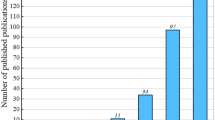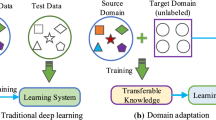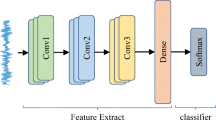Abstract
Intelligent machinery fault diagnosis system has been receiving increasing attention recently due to the potential large benefits of maintenance cost reduction, enhanced operation safety and reliability. This paper proposes a novel deep learning method for rotating machinery fault diagnosis. Since accurately labeled data are usually difficult to obtain in real industries, data augmentation techniques are proposed to artificially create additional valid samples for model training, and the proposed method manages to achieve high diagnosis accuracy with small original training dataset. Two augmentation methods are investigated including sample-based and dataset-based methods, and five augmentation techniques are considered in general, i.e. additional Gaussian noise, masking noise, signal translation, amplitude shifting and time stretching. The effectiveness of the proposed method is validated by carrying out experiments on two popular rolling bearing datasets. Fairly high diagnosis accuracy up to 99.9% can be obtained using limited training data. By comparing with the latest advanced researches on the same datasets, the superiority of the proposed method is demonstrated. Furthermore, the diagnostic performance of the deep neural network is extensively evaluated with respect to data augmentation strength, network depth and so forth. The results of this study suggest that the proposed intelligent fault diagnosis method offers a new and promising approach.
















Similar content being viewed by others
References
Abdel-Hamid, O., Mohamed, A., Hui, J., & Penn, G. (2012). Applying convolutional neural networks concepts to hybrid NN-HMM model for speech recognition. In Proceedings of IEEE international conference on acoustics, speech and signal processing (pp. 4277–4280).
Aydin, i, Karakose, M., & Akin, E. (2015). Combined intelligent methods based on wireless sensor networks for condition monitoring and fault diagnosis. Journal of Intelligent Manufacturing, 26(4), 717–729.
Bin, G. F., Gao, J. J., Li, X. J., & Dhillon, B. S. (2012). Early fault diagnosis of rotating machinery based on wavelet packets—Empirical mode decomposition feature extraction and neural network. Mechanical Systems and Signal Processing, 27, 696–711.
Chen, X. H., Cheng, G., Shan, X. L., Hu, X., Guo, Q., & Liu, H. G. (2015). Research of weak fault feature information extraction of planetary gear based on ensemble empirical mode decomposition and adaptive stochastic resonance. Measurement, 73, 55–67.
Du, W., Tao, J., Li, Y., & Liu, C. (2014). Wavelet leaders multifractal features based fault diagnosis of rotating mechanism. Mechanical Systems and Signal Processing, 43(1–2), 57–75.
Gan, M., Wang, C., & Zhu, C. (2018). Fault feature enhancement for rotating machinery based on quality factor analysis and manifold learning. Journal of Intelligent Manufacturing, 29(2), 463–480.
Guo, X., Chen, L., & Shen, C. (2016). Hierarchical adaptive deep convolution neural network and its application to bearing fault diagnosis. Measurement, 93, 490–502.
He, K. M., Zhang, X. Y., Ren, S. Q., & Sun, J. (2015). Deep residual learning for image recognition. arXiv preprint arXiv:1512.03385.
He, K. M., Zhang, X. Y., Ren, S. Q., & Sun, J. (2016). Identity mappings in deep residual networks. In Proceedings of European conference on computer vision, Cham, Switzerland (pp. 630–645).
Hinton, G., Vinyals, O., & Dean, J. (2015). Distilling the knowledge in a neural network. arXiv preprint arXiv:1503.02531.
Ioffe, S., & Szegedy, C. (2015). Batch normalization: Accelerating deep network training by reducing internal covariate shift. In Proceedings of 32nd international conference on machine learning, Lile, France (Vol. 1, pp. 448–456).
Jaitly, N., & Hinton, G. E. (2013). Vocal tract length perturbation (VTLP) improves speech recognition. In Proceedings of ICML workshop on deep learning for audio, speech and language.
Jin, X., Zhao, M., Chow, T. W. S., & Pecht, M. (2014). Motor bearing fault diagnosis using trace ratio linear discriminant analysis. IEEE Transactions on Industrial Electronics, 61(5), 2441–2451.
Krizhevsky, A., Sutskever, I., & Hinton, G. E. (2012). ImageNet classification with deep convolutional neural networks. In Proceedings of 26th annual conference on neural information processing systems (Vol. 2, pp. 1097–1105).
Lee, J., Qiu, H., Yu, G., Lin, J., & Rexnord Technical Services (2007). IMS, University of Cincinnati. “Bearing Data Set”, NASA Ames Prognostics Data Repository. Moffett Field, CA: NASA Ames Research Center. http://ti.arc.nasa.gov/project/prognostic-data-repository. Accessed 2017.
Lei, Y., Jia, F., Lin, J., Xing, S., & Ding, S. X. (2016). An intelligent fault diagnosis method using unsupervised feature learning towards mechanical big data. IEEE Transactions on Industrial Electronics, 63(5), 3137–3147.
Li, H., Lian, X., Guo, C., & Zhao, P. (2015). Investigation on early fault classification for rolling element bearing based on the optimal frequency band determination. Journal of Intelligent Manufacturing, 26(1), 189–198.
Li, R., Sopon, P., & He, D. (2012). Fault features extraction for bearing prognostics. Journal of Intelligent Manufacturing, 23(2), 313–321.
Li, W., Zhang, S., & He, G. (2013). Semisupervised distance-preserving self-organizing map for machine-defect detection and classification. IEEE Transactions on Instrumentation and Measurement, 62(5), 869–879.
Li, X., Ding, Q., & Sun, J.-Q. (2018a). Remaining useful life estimation in prognostics using deep convolution neural networks. Reliability Engineering & System Safety, 172, 1–11.
Li, X., Zhang, W., & Ding, Q. (2018b). Cross-domain fault diagnosis of rolling element bearings using deep generative neural networks. IEEE Transactions on Industrial Electronics. https://doi.org/10.1109/TIE.2018.2868023.
Li, X., Zhang, W., & Ding, Q. (2018c). A robust intelligent fault diagnosis method for rolling element bearings based on deep distance metric learning. Neurocomputing, 310, 77–95.
Lu, C., Wang, Z. Y., Qin, W. L., & Ma, J. (2017). Fault diagnosis of rotary machinery components using a stacked denoising autoencoder-based health state identification. Signal Processing, 130, 377–388.
Mao, W., He, L., Yan, Y., & Wang, J. (2017). Online sequential prediction of bearings imbalanced fault diagnosis by extreme learning machine. Mechanical Systems and Signal Processing, 83(15), 450–473.
Qiu, H., Lee, J., Lin, J., & Yu, G. (2006). Wavelet filter-based weak signature detection method and its application on rolling element bearing prognostics. Journal of Sound and Vibration, 289(4–5), 1066–1090.
Ragab, A., Ouali, M.-S., Yacout, S., & Osman, H. (2016). Remaining useful life prediction using prognostic methodology based on logical analysis of data and kaplanmeier estimation. Journal of Intelligent Manufacturing, 27(5), 943–958.
Seera, M., Lim, C. P., & Loo, C. K. (2016). Motor fault detection and diagnosis using a hybrid FMM-CART model with online learning. Journal of Intelligent Manufacturing, 27(6), 1273–1285.
Smith, W. A., & Randall, R. B. (2015). Rolling element bearing diagnostics using the Case Western Reserve University data: A benchmark study. Mechanical Systems and Signal Processing, 64–65, 100–131.
Sun, W., Shao, S., Zhao, R., Yan, R., Zhang, X., & Chen, X. (2016). A sparse auto-encoder-based deep neural network approach for induction motor faults classification. Measurement, 89, 171–178.
Tian, Z. (2012). An artificial neural network method for remaining useful life prediction of equipment subject to condition monitoring. Journal of Intelligent Manufacturing, 23(2), 227–237.
van Wyk, B. J., van Wyk, M. A., & Qi, G. (2009). Difference histograms: A new tool for time series analysis applied to bearing fault diagnosis. Pattern Recognition Letters, 30(6), 595–599.
Wang, C., Gan, M., & Zhu, C. A. (2016). A supervised sparsity-based wavelet feature for bearing fault diagnosis. Journal of Intelligent Manufacturing. https://doi.org/10.1007/s10845-016-1243-9.
Wang, C., Gan, M., & Zhu, C. A. (2017). Intelligent fault diagnosis of rolling element bearings using sparse wavelet energy based on overcomplete DWT and basis pursuit. Journal of Intelligent Manufacturing, 28(6), 1377–1391.
Wu, C., Chen, T., Jiang, R., Ning, L., & Jiang, Z. (2017). A novel approach to wavelet selection and tree kernel construction for diagnosis of rolling element bearing fault. Journal of Intelligent Manufacturing, 28(8), 1847–1858.
Xiao, L., Chen, X., Zhang, X., & Liu, M. (2017). A novel approach for bearing remaining useful life estimation under neither failure nor suspension histories condition. Journal of Intelligent Manufacturing, 28(8), 1893–1914.
Yang, B. S., Di, X., & Han, T. (2008). Random forests classifier for machine fault diagnosis. Journal of Mechanical Science and Technology, 22(9), 1716–1725.
Zhang, X., Chen, W., Wang, B., & Chen, X. (2015). Intelligent fault diagnosis of rotating machinery using support vector machine with ant colony algorithm for synchronous feature selection and parameter optimization. Neurocomputing, 167, 260–279.
Zhang, X., Liang, Y., Zhou, J., & Zang, Y. (2015). A novel bearing fault diagnosis model integrated permutation entropy, ensemble empirical mode decomposition and optimized SVM. Measurement, 69, 164–179.
Zhang, Z., Wang, Y., & Wang, K. (2013). Fault diagnosis and prognosis using wavelet packet decomposition, fourier transform and artificial neural network. Journal of Intelligent Manufacturing, 24(6), 1213–1227.
Zhou, Q., Yan, P., Liu, H., & Xin, Y. (2017). A hybrid fault diagnosis method for mechanical components based on ontology and signal analysis. Journal of Intelligent Manufacturing. https://doi.org/10.1007/s10845-017-1351-1.
Ziani, R., Felkaoui, A., & Zegadi, R. (2017). Bearing fault diagnosis using multiclass support vector machines with binary particle swarm optimization and regularized Fishers criterion. Journal of Intelligent Manufacturing, 28(2), 405–417.
Acknowledgements
The material in this paper is based on work supported by Grants (11172197, 11332008, and 11572215) from the National Science Foundation of China, and Grants (N170503012, N170308028) from the Fundamental Research Funds for the Central Universities.
Author information
Authors and Affiliations
Corresponding author
Rights and permissions
About this article
Cite this article
Li, X., Zhang, W., Ding, Q. et al. Intelligent rotating machinery fault diagnosis based on deep learning using data augmentation. J Intell Manuf 31, 433–452 (2020). https://doi.org/10.1007/s10845-018-1456-1
Received:
Accepted:
Published:
Issue Date:
DOI: https://doi.org/10.1007/s10845-018-1456-1




